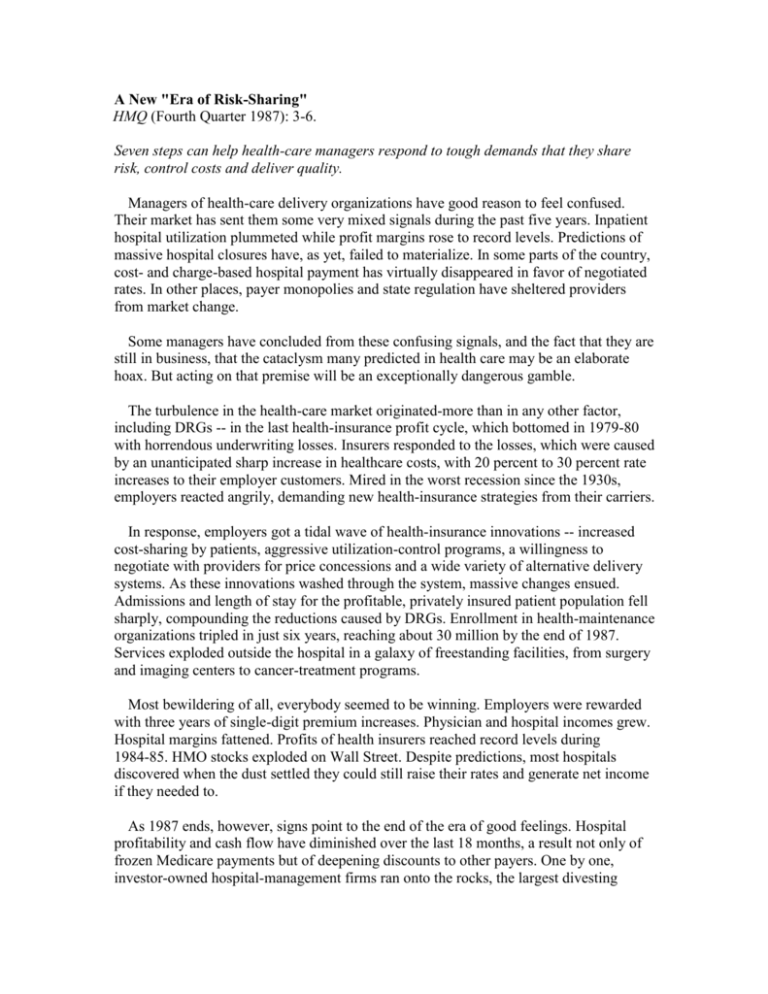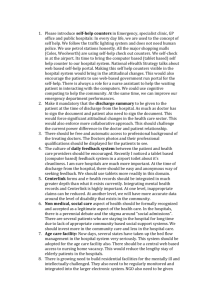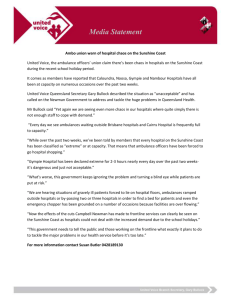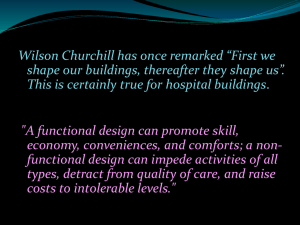A New "Era of Risk-Sharing"
advertisement

A New "Era of Risk-Sharing" HMQ (Fourth Quarter 1987): 3-6. Seven steps can help health-care managers respond to tough demands that they share risk, control costs and deliver quality. Managers of health-care delivery organizations have good reason to feel confused. Their market has sent them some very mixed signals during the past five years. Inpatient hospital utilization plummeted while profit margins rose to record levels. Predictions of massive hospital closures have, as yet, failed to materialize. In some parts of the country, cost- and charge-based hospital payment has virtually disappeared in favor of negotiated rates. In other places, payer monopolies and state regulation have sheltered providers from market change. Some managers have concluded from these confusing signals, and the fact that they are still in business, that the cataclysm many predicted in health care may be an elaborate hoax. But acting on that premise will be an exceptionally dangerous gamble. The turbulence in the health-care market originated-more than in any other factor, including DRGs -- in the last health-insurance profit cycle, which bottomed in 1979-80 with horrendous underwriting losses. Insurers responded to the losses, which were caused by an unanticipated sharp increase in healthcare costs, with 20 percent to 30 percent rate increases to their employer customers. Mired in the worst recession since the 1930s, employers reacted angrily, demanding new health-insurance strategies from their carriers. In response, employers got a tidal wave of health-insurance innovations -- increased cost-sharing by patients, aggressive utilization-control programs, a willingness to negotiate with providers for price concessions and a wide variety of alternative delivery systems. As these innovations washed through the system, massive changes ensued. Admissions and length of stay for the profitable, privately insured patient population fell sharply, compounding the reductions caused by DRGs. Enrollment in health-maintenance organizations tripled in just six years, reaching about 30 million by the end of 1987. Services exploded outside the hospital in a galaxy of freestanding facilities, from surgery and imaging centers to cancer-treatment programs. Most bewildering of all, everybody seemed to be winning. Employers were rewarded with three years of single-digit premium increases. Physician and hospital incomes grew. Hospital margins fattened. Profits of health insurers reached record levels during 1984-85. HMO stocks exploded on Wall Street. Despite predictions, most hospitals discovered when the dust settled they could still raise their rates and generate net income if they needed to. As 1987 ends, however, signs point to the end of the era of good feelings. Hospital profitability and cash flow have diminished over the last 18 months, a result not only of frozen Medicare payments but of deepening discounts to other payers. One by one, investor-owned hospital-management firms ran onto the rocks, the largest divesting hospitals and the smaller defaulting on interest payments or declaring bankruptcy. HMO profitability eroded sharply or disappeared altogether as the costs of growing and caring for their enrollees passed their revenues. Profitability of health insurers, which declined sharply during 1986, continued to decline during 1987. And employers, who may have believed that health-care inflation had been tamed, were blindsided by 15 percent to 20 percent increases in their premiums -- against a background of general inflation at 4 to 5 percent. Thus, as 1988 begins, physicians and hospitals are entering a new health-insurance cycle and a new wave of counter-responses. The hefty rate increases for indemnity insurance will permit HMOs, which have marginally better control over their costs, to increase their revenues and profits without losing market momentum. HMO enrollment will receive an unexpected but timely boost. So-called "managed-premium" products, such as preferred provider organizations, which received a mixed reception from employers during the mid-1980s, will also benefit. Employers will find an array of "unbundled" cost-management services available for restraining hospital and physician utilization. The late 1980s will be the era of "ambulatory cost containment." Ambulatory services were the principal culprits in the large run-up in health costs during 1986- 87. By the end of the decade, prior approval of practically all diagnostic and surgical procedures, inpatient or outpatient, will be virtually universal. Insurers will also be looking for ways to contain psychiatric and substance-abuse costs and may turn to at-risk utilization-control programs that broker these services. Other insurer tactics are likely to include "redlining" of providers-that is, refusing to pay for services rendered by hospitals or physicians whose fees or utilization profiles are exceptionally high. Also, employee risk-sharing may be graded to the relative cost of services received. In other words, the higher-cost facility the patient uses, the larger share of the costs the patient will pay out of pocket. Most important, the proportion of health-insurance plans that force providers to share risk through negotiated rates or capitation will rise from less than 20 percent of the private insurance market to 50 percent or more by the early 1990s. Regional variation in this percentage will be significant. In some markets, such as Southern California, close to 80 percent of hospital payment already comes from prospectively determined or negotiated rates. In others, such as the Southeast, negotiated rates are an insignificant fraction of total hospital revenues. Planning for an era of risk-sharing and responsibility for managing cost and quality will require a change in hospital management focus. Hospital strategy during the 1980s focused almost entirely on revenue growth. Large advertising and business-development outlays, discounting in anticipation of volume gains, marketing excess capacity through captive insurance-all these strategies were posited on profit enhancement that has, by and large, not materialized. Revenue growth without profitability is not worth pursuing. Indeed, the best leading indicator of trouble for investor-owned hospitals was that return on assets declined steadily during the 1980s, even as revenues continued to grow vigorously. While many hospitals began developing a cost-management capability by installing cost-accounting and productivity systems, only a tiny fraction of hospitals have reliable information on the profitability of individual DRGS. With many California hospitals having upwards of a hundred separate insurance contracts, only a handful can determine if they are making or losing money on any of them. How should health-care managers respond to an era of risk-sharing and economic limits? I asked that question of managers in markets that have reached a kind of payer-provider gridlock, where managed-care plans have 30 percent or more of the market. What would these managers have done five years ago to position themselves more effectively for today's markets? Their answers lead to seven major recommendations. One -- Involve physicians. Managers alone simply cannot manage cost and quality under negotiated rates. Physicians generate costs by how, and how much, they use the hospital to treat patients. Unless a program of shared risk and responsibility for assuring quality with negotiated cost constraints involves both management and medical staff, it will inevitably fail. Donald C. Wegmiller, president of HealthOne Corporation in Minneapolis, observed that payers in the Twin Cities were able to deal separately with hospitals and physicians, to the disadvantage of both. Wegmiller believes that a prime missed opportunity was the failure of hospitals to involve physicians intimately in strategic planning. He has suggested that involving physicians in key governance and management roles will be the ultimate solution to integrating clinical and financial decision-making. Two -- Get better information. Hospital managements scrambled during the 1980s to install computerized cost-accounting and productivity systems. Progress has been agonizingly slow. Hospitals need the ability to cost out key clinical services and reorganize their cost structures by product groupings (oncology, women's services, etc.). Even those who have such information have had difficulty in developing management structures that hold designated managers and physicians responsible for managing cost and quality within the product area. Unless this information is used to make managers accountable, hospitals will not have control over their economic destinies in a brokered health-care environment. Three -- Manage contracts. Many hospitals stumbled their way through the first few years of contracting without either monitoring their economic performance or managing the process of contract renewal. In some markets, contracts have proliferated so much that a computer and full-time staff are required to track them. Finance, operations and medical staff quality assurance must work together to troubleshoot problems in contract performance and be involved in decisions to renew or terminate contracts at renewal time. Contract management and tracking is a full-time job and should be staffed accordingly. Four -- Improve productivity. Because hospitals have gotten so diverse and complex, it has become even more difficult to improve productivity. Yet it is clear that costs will rise more rapidly than revenues in institutions that do not improve their productivity. Even adjusting for increased outpatient activity, full-time employment per adjusted occupied bed rose in community hospitals in the last five years as large bureaucracies inside hospitals geared up for competition. The end of the 1980s will be an era of reducing white-collar employment inside hospitals and of reducing the number of layers between the CEO and the patient. The ratio of meeting-goers to care-givers will be cut significantly. It will also be an era of cross-training of technical and nursing personnel, after more than a decade of rampant specialization. Given the worsening shortage of nurses, more flexible and sparing use of nursing personnel will be essential. Five -- Position for direct contracting. Many hospitals attempted unsuccessfully to compete in the health-insurance market through captive plans. However, the opportunity to contract with employers directly, bypassing the insurance middleman, may become increasingly attractive as employers realize how much insurance overhead affects their benefit costs. Direct contracting could be a life-saving strategy for rural hospitals, whose communities pay an enormous price for the out-migration of patients to metropolitan areas. Positioning to contract directly with employers, however, requires not only the capability to manage cost and quality, but also comprehensive service offerings and convenient patient access to primary care. Much of the merger activity taking place in highly competitive markets, such as Minneapolis, San Francisco and Portland, Oregon, has been directed toward achieving metropolitan area-wide health service coverage within a single system. Not all providers will be able to achieve this coverage. For many, the merger activity and attendant complexity of governance and management may cancel out any market advantage. Six -- Drive a hard bargain. "Give our health plan a discount and we'll increase your market share" will be recorded as one of the three great lies of the 1980s in American health care. Market share has not measurably moved as a result of health-insurance contracting in most markets. Growing numbers of hospitals are refusing to discount if they are the low-cost provider or unless the discount is contingent on incremental volume. As suggested above, health insurers are on the defensive, and their bargaining positions are certain to harden. Hospitals and physicians must not permit themselves to be stampeded into unrealistic price concessions and must likewise avoid kamikaze pricing. If everybody can contract with you at your marginal cost, or you are making a lot of speculative, below-cost deals, you're on your way out of business. Seven -- Manage for value. As Honda demonstrated in conquering the American auto market, the strongest competitive position is to give the customer superior value (superior quality at a competitive price). High-quality providers, such as regional multi-specialty group practices and teaching institutions, increased their market shares during the 19 80s. Marginal providers with mediocre medical staffs and aging facilities have fared badly, as witnessed by the second- and third-tier hospital-management firms who offered inferior products at high prices. Some providers cling to the self-serving belief that cost and quality are correlated. Assuming that employers and insurers will continue to pay high prices for services whose relative value they cannot yet measure could be fatal to high-cost institutions. Price alone will not be enough to achieve market dominance, but those providers who can manage successfully for quality as well as cost will be in a prohibitively strong position as this confusing decade comes to an end. The author acknowledges the assistance of three people whose experiences and editorial suggestions helped shape this article: Donald C. Wegmiller, president of HealthOne Corporation, Minneapolis; William Kerr, director, University of California at San Francisco Medical Center; and John Lee, administrator, Providence Medical Center, Portland, Oregon.








